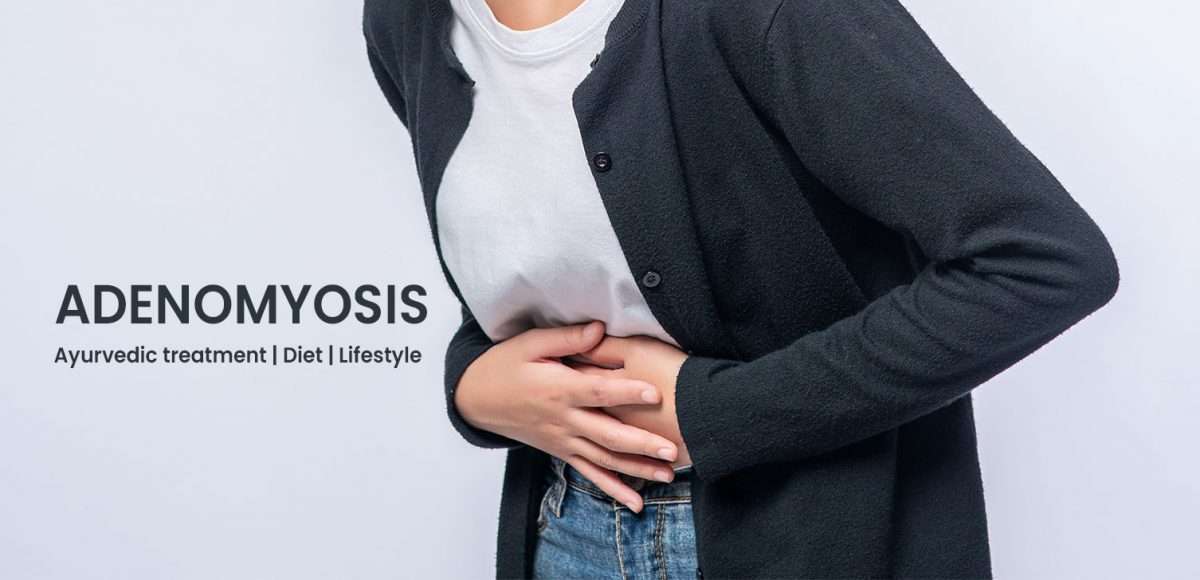Adenomyosis: Ayurveda Treatment

Ayurveda is a holistic science that follows a comprehensive approach to diseases. Let’s have a look at how Ayurveda assists in managing adenomyosis. A reverse abnormal condition of endometriosis in which endometrium grows in the uterine walls is termed as Adenomyosis. It can be at certain places in the uterus or grow all over it and causes damage to the uterus from within. This causes the uterus to swell, resulting in pain and heavy bleeding.
In the majority cases, adenomyosis has no signs and symptoms and if it’s not treated at the right time, it could cause severe health issues.
Causes
Adenomyosis is a frequently seen ailment in women nowadays. Prior uterine treatment for C-section, fibroid removal, dilatation, and curettage acts as a risk factor. The actual cause of adenomyosis is still unknown.
Among the widely assumed causes are the following:
- Imbalances in oestrogen and progesterone can cause the uterine lining to thicken, leading to adenomyosis.
- Uterine fibroids are benign growths that can form in the uterus. They can cause uterine enlargement and progress to adenomyosis.
- Hormone imbalances in oestrogen and progesterone can cause the uterine lining to thicken, leading to adenomyosis.
- Pelvic inflammatory disease is an infection occurring in the reproductive system that can develop into adenomyosis.
- Previous uterine removal procedures, such as a C-section, hysterectomy, or D&C (dilation and curettage), can result in knots and scars. This damage can result in adenomyosis.
- Intrauterine devices, or IUDs, may cause the lining of the uterus to thicken, which may eventually give rise to adenomyosis.
- Pregnancy induces the uterus to stretch and expand, which may later lead to adenomyosis.
- Medications that trigger hormonal changes, such as contraceptive pills, might cause adenomyosis.
- Autoimmune disorders linked to uterine wounds might increase the chance of abnormal uterine growth.
- Damages resulting from consecutive terminations of pregnancy.
Symptoms
- Enlarged uterus due to uterine or endometrial fibroid growth and adenomyosis
- Heavy or extended menstrual bleeding with dark, brownish-red, and clotted menstrual flow
- Premenstrual syndrome (PMS) and severe menstrual cramps that begin 2-3 days prior to the period and disappear with a regular flow
- Discomfort and pain during intercourse
- Abdominal pressure or bloating
- Frequent urination and pain during micturition
- Constipation or diarrhoea
- Thigh and leg cramps
- Pain in the pelvic area, lower abdomen, and lower back
- Anaemia, tiredness, and dizziness as a result of heavy periods
- Fertility issues, trouble conceiving, and infertility complications
- Inconsistent menstruation; frequent urinary tract infections
- Abnormal pregnancy, preterm delivery, or premature endometrial shedding
- Endometriosis and uterine fibroids develop as a result of adenomyosis.
- Endometrial polyps
Ayurvedic Treatment for Adenomyosis
According to Ayurveda, when there is difficulty with the menstrual cycle, there is an imbalance in the Vata of the body. And if you have a lot of pain and clotting, you probably have a pitta and kapha imbalance as well.
Detoxification Your Ayurvedic practitioner may recommend detoxification therapy in the initial stage of the therapy. This therapy is used to clear the body of toxins. This also works on the patient’s internal difficulties. This also helps in preparing the body to adjust to the treatment regimen.
Abhyanga: Abhyanga is a type of ayurvedic massage that helps to minimise the build-up of tissue and lining. This massage dries up the tissues and lowers Vata Dosha which aids in minimising uterine enlargement.
Basti: Basti has been shown to be extremely beneficial in the treatment of adenomyosis. This is a type of herbal enema that is introduced into the uterus. This aids in the stabilisation of ovulation and hormonal functioning.
Uttarbasti: Uttarbasti is a specialised Ayurvedic practice used to manage adenomyosis. The ayurvedic practitioner inserts kadha, ayurvedic oils, and medicines into the uterus during Uttarbasti. This procedure could help to remove the extra uterine lining and return the uterus to its normal size.
Herbs: herbs are provided in the course of your ayurvedic therapy. This helps in rejuvenating the body and eliminating toxins. And these herbs will balance the vitiated Dosha in the body.
Diet
- Follow a pitta-balancing diet. Leafy greens, ginger, turmeric, and omega-3 fatty acids should all be included. These foods aid in the reduction of inflammation and discomfort, the balance of pitta dosha, and the promotion of hormone balance.
- Staying hydrated is also essential, so drink sufficient water.
- Caffeine, alcohol, and processed foods are all trigger foods that should be avoided.
- Avoid items that are fried, hot, sour, or spicy from your diet.
- Smaller meals throughout the day are preferable.
- Consume freshly cooked, healthy meals at the appropriate times.
- Have fresh fruits and vegetables.
- Include high-fibre foods in your diet.
- Ghee, almonds, walnuts, and other nuts can help you become healthier and regulate your menstrual cycle.
Conclusion
Adenomyosis is a common condition in women that affects the reproductive system. Ayurvedic adenomyosis treatment is a nonsurgical way of treating the root cause with the intake of certain Ayurvedic medicines and changes in diet and lifestyle as per the guidance of a registered practitioner.
Consult our experts at Ayurclinic Melbourne, if you suspect any of the above symptoms. Our practitioners can provide you with personalised Ayurvedic Adenomyosis Treatment and guide you towards a healthy life.







